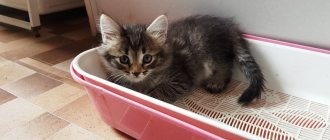13562Administration
Many cat owners are concerned about the question: “Is it possible to sterilize a cat during heat?”, because the question of sterilization always arises sooner or later.
Sterilization is an operation during which the reproductive organs are removed, after which the animal loses its reproductive functions. This operation is performed all over the world, and if performed correctly, there are no complications.
Reasons to sterilize:
- There are no plans to breed kittens;
- During estrus she is a nuisance;
- Tablets designed to reduce sexual activity in cats negatively affect the health of the animal.
Some owners feel bad about spaying their cat because it will cause her to suffer. In fact, she will be much worse off from prolonged abstinence during heat, especially when taking pills.
© shutterstock
Veterinarians advise sterilizing animals in order not to harm their health due to abstinence, or to avoid producing stray kittens.
Why do you need to sterilize your cat?
After puberty, cats begin to look for a mate. They leave scent marks, scream at night and constantly try to escape from the house. This is a difficult period for every owner. Despite the difficulties that arise, not everyone is in a hurry to resort to surgical intervention, fearing possible risks. Most often, owners resort to an alternative solution - hormonal drugs. They really suppress sexual desire, but with constant use they carry much more risks: the growth of tumors, the development of pathologies of the reproductive system (cyst, pyometra) and urinary systems.
Unlike hormonal drugs, sterilization permanently eliminates sexual desire and reproductive function. It has a beneficial effect on the pet’s condition, protects it from cancer and prolongs its life.
Favorable time to sterilize a cat
Doctors recommend surgery to remove the reproductive organs of domestic cats that have reached 6-8 months of age. It is advisable to perform the procedure before the first heat. Such forethought will have a beneficial effect on the mental health of your pet.
If time is lost and the cat urgently demands a cat, which creates serious problems for its owners, there is no point in postponing the procedure. In such cases, veterinarians recommend spaying the cat during heat, despite the risks of complications. A good doctor will do everything possible to prevent negative consequences for the tailed patient.
Difference between castration and sterilization
Sterilization (oophorectomy) is tubal ligation with or without removal of the ovaries. Most often, veterinarians perform castration (ovariohysterectomy), which involves removing not only the ovaries, but also the uterus. This method is more effective, as it eliminates the development of tumors and inflammatory diseases in the uterus.
Many people confuse these concepts, separating them not by the specifics of the procedure, but by gender. In everyday life, it is believed that females are sterilized and males are castrated. For convenience, instead of “castration” we will use the more familiar term “sterilization”.
Terms of sterilization during estrus
There are only two simple rules that are best adhered to:
- Or sterilization is carried out as soon as the first signs of estrus are noticeable.
- Or the operation is performed towards the very end.
Important! It is impossible to perform the procedure in the midst of sexual heat.
At this time, the maximum concentration of sex hormones is observed in the animal’s blood; the blood supply to the uterus and other organs of the reproductive system is also close to peak values. Performing an operation during this period is a strong risk, and not very justified.
Brief description of the operation
To minimize possible complications, preparatory measures are recommended. They include not only actions immediately before surgery, but also ongoing disease prevention. In particular, this refers to annual vaccination.
Preparing the animal
Anesthesia weakens the immune system, increasing the risk of infection by harmful microorganisms and parasites. For safety, it is recommended to vaccinate your pet at least a month before the procedure. Treatment for helminths is carried out within 1.5-2 weeks. In the absence of timely vaccination, the cat is given a serum injection that stimulates a stable immune response for 2 weeks.
A few days before surgery, a urine and blood test is taken from the tailed patient. To determine the safe dosage of a narcotic substance, the functioning of the heart and respiratory organs is checked using ultrasound and x-rays.
It is recommended to give up feeding 12 hours before, and water 3 hours before. This eliminates the occurrence of vomiting, which provokes the development of aspiration pneumonia.
Choosing a clinic and veterinarian
Pets that don't go outside are afraid to leave their familiar territory. To minimize stress, it is better to choose a clinic closer to home. Walking distance will eliminate travel by transport, reducing the time you spend outside your usual conditions.
For especially timid pets, calling a veterinarian to your home is a good idea. This eliminates the stress caused by a change of environment and the risk of infection from other visitors. The disadvantage of home surgery is the low sterility and lack of equipment necessary to eliminate possible complications. Most clinics provide both types of services, so the choice is up to the owner.
It is ideal if you vaccinate your animal and take it for routine examinations to the same clinic and to the same doctor. A regular veterinarian is familiar with the characteristics of the body.
Progress of the procedure
After anesthesia is administered to the tailed patient, the hair is removed at the site of the future incision or puncture. The procedure itself is carried out in two ways:
- surgical, involving classical excision with a scalpel;
- laparoscopic, based on the creation of small punctures using endoscopic equipment.
In both cases, after making an incision, the surgeon removes the reproductive organs and applies stitches. They are removable and non-removable. The first ones are removed 7-10 days after the procedure, and the second ones resolve on their own.
Preparing for surgery
Preparing your cat for sterilization involves making sure she has enough water the night before surgery. You cannot feed your pet 10-12 hours before the procedure.
It is necessary to carry out a thorough examination of the cat by a specialist in advance and, if necessary, take tests. Transporting the animal should be done as comfortably as possible so that the cat does not experience severe stress. It is recommended to take a warm blanket or blanket with you to the clinic, as well as a well-absorbent bedding or special diapers.
Before the operation, the specialist re-examines the animal and, if there are no contraindications, proceeds with the manipulation. Identification of symptoms of intoxication - fever, elevated temperature, as well as some diseases is a reason to postpone the procedure.
Pros and cons of sterilization at different ages
When sterilizing, age plays a primary role. Veterinarians' opinions on the ideal age vary, but the fact that a young body is at lower risk remains the same.
Early (before first heat)
Foreign veterinarians believe that it is better to sterilize a cat when it has not yet reached puberty. This approach guarantees rapid tissue regeneration, reducing postoperative risks. Surgery is performed at 3-6 months.
Opponents of this approach cite possible developmental delays, changes in behavioral characteristics, and the development of pathologies of the eyes, kidneys and endocrine system. There is no consensus here, since supporters of early sterilization have a completely opposite opinion. They are confident that the operated animal grows up healthier.
During puberty
Most veterinarians recommend operating on your pet closer to her first heat, that is, at 7-8 months. Exceptions include kittens of different sexes from the same litter growing up together. They reach puberty earlier, so the date of surgery can be delayed by 4-6 months. Before making a decision, the veterinarian weighs the tailed patient. Its weight should be at least 2.5-3 kg. Otherwise, the operation will be delayed.
In old age
People who have picked up adult animals on the street are constantly wondering at what age a cat can be sterilized. In their case, the chance for early intervention has already been missed, so the issue is resolved individually.
Veterinarians believe that surgery is possible up to 10 years of age. After this age, the pet is considered old, and the likelihood of complications increases to a critical level. Surgery is performed only for special indications that threaten the life of the tailed patient.
Features of sexual development in different breeds
The timing of puberty varies from breed to breed. If your pet begins to show signs of heat too early, check with your veterinarian at what age cats of this breed are sterilized. Representatives of the Siamese-Oriental group mature from 4 months, and large long-haired breeds (Maine Coons, Persians, Siberians) - up to 1 year.
Post-operative care
After the operation, the animal, while it is still under anesthesia, must be placed in a warm place. It is advisable to lay it on its side and place a heating pad next to it. At the same time, you cannot put her on an elevated place, because after anesthesia she has poor control of her movements and may fall and get injured.
After the operation, the animal will not eat, and there is no need to force it, but drinking water must be provided.
You need to try feeding the next day; you should give wet food in small portions. There are special foods for the postoperative period that have a positive effect on the functioning of the digestive tract.
© shutterstock
To prevent the animal from licking the seams and damaging them, it is necessary to put a special collar on it, which is removed only during feeding. Immediately after the operation, the pet must be taken home as quickly as possible and wrapped up, because under anesthesia their body temperature drops. also necessary to turn it over every half hour from one side to the other, and close your eyes so that they do not dry out. It is necessary to constantly monitor him and show him the care that he really needs now.
What age is ideal - veterinarians' opinions
Doctors' opinions on what age is best to sterilize cats agree on one thing. Each subsequent year after the onset of estrus reduces the effectiveness of the procedure and increases the likelihood of complications.
The probability of developing oncology in animals operated on before their first heat is only 0.5%. At the time of surgery, the pet must be at least 7-8 months old. The exception is breeds with early maturity or kittens from the same litter.
Features of the rehabilitation period
The postoperative period during standard abdominal surgery depends on the individual characteristics of the animal, as well as the course of the surgical procedure. Typically, recovery takes about one week. During rehabilitation, it is necessary to wear a special bandage, as well as a collar; such measures prevent injury to the stitches and licking of wounds. Sutures are removed on average a week after the operation. If absorbable suture material is used, this procedure is not indicated.
Read more about how to care for a cat after sterilization.
Wound treatment is carried out using special antiseptic solutions. Chlorhexidine or Miramistin are most often prescribed. Treatment of sutures helps prevent the addition of a secondary bacterial infection.
It is recommended to carefully monitor the animal for a week or a week and a half to prevent jumping from great heights or injury as a result of a fight with another pet. It is also recommended to limit your pet’s contact with small children.
Diet therapy involves reducing the load on the digestive tract. Constipation should not be allowed to occur, as an increase in intra-abdominal pressure can lead to suture divergence. Therefore, it is recommended to enrich your cat’s diet with soft food and sufficient water.
The rehabilitation period after laparoscopic intervention is much easier. Its duration varies from several days to a week. Despite the low tissue trauma, it is still recommended to wear a bandage. During the recovery period, high physical activity is not allowed in the first two days. In the future, the cat can return to its usual lifestyle.
Estrus, pregnancy and childbirth
Not all owners understand the relationship between the reproductive and reproductive systems. Because of this, it is completely unclear when to spay a cat: before, during or after heat. Even more difficulties arise with the need for childbirth. Many owners mistakenly believe that deprivation of reproductive function is safe only after bearing at least one litter.
Surgery during pregnancy
Surgery is permissible if the pregnancy is no more than 1 month. Otherwise, there is a possibility of increased blood loss and a prolonged postoperative period. Intervention is also permissible in case of abnormal fetal development, poor health or old age, which prevents the safe bearing of kittens. In all other cases, the operation is postponed until complete postpartum recovery.
Surgery after childbirth
After giving birth, a young mother needs 2-3 months to fully recover. During this time, the uterus returns to its original size, and blood circulation in the pelvis is normalized.
Emergency intervention immediately after the birth of kittens is practiced when:
- detection of tumors in the reproductive organs;
- the presence and high probability of postpartum hemorrhage;
- uterine rupture;
- damage or abnormalities of the placenta.
In these situations, the risk of possible complications is higher than the risks associated with sterilization. The procedure is considered justified.
Is it necessary for a cat to give birth at least once before sterilization?
The most popular question arising from the baseless myth about the “joy of motherhood.” From a psychological point of view, animals are not subject to emotions and act instinctively. The absence or presence of pregnancy is taken for granted by them, and therefore does not have a fundamental impact on their lives.
An obvious logic appears when considering the issue from a biological point of view. Before pregnancy, female sex hormones (estrogens), responsible for sexual desire, are produced by the ovaries. If they are removed in a timely manner, the animal loses not only the ability to conceive, but also interest in the opposite sex. Otherwise, other internal secretion organs are involved in the production of estrogen. As a result, the operated pet will not be able to become pregnant again, but will continue its loud rituals of calling cats. If you do not want to endure such concerts for the rest of your furry pet’s life, do not allow mating until sterilization.
In addition to the high risk of retaining some sex hormones, pregnancy reduces the effect of the procedure. The probability of developing cancer after the first birth is 8%, and after the second it increases by more than 3 times.
Is it possible to operate on a cat during heat?
During estrus, hormonal changes occur. Any intervention is fraught with multiple complications, including the development of oncology. Due to the dilation of blood vessels, there is a high probability of heavy blood loss. Animals recover from anesthesia worse and have a more difficult time experiencing the postoperative period.
It is safer to carry out surgery 2 weeks before or after estrus, when the pet’s condition returns to normal. Exceptions include prolonged heats with a short interval between them. They impair quality of life and lead to exhaustion. In this case, the animal is sterilized for medicinal purposes.
Changes in physiology and behavior
The first heat or estrus begins in cats after the completion of puberty at 6–10 months, in large breeds later. From this moment on, it repeats regularly, accompanied by hormonal surges and behavioral changes.
The sexual cycle consists of the following stages:
- The preparatory period , proestrus , lasts 2–3 days. Under the influence of the gonadotropic hormone of the pituitary gland, the growth of ovarian follicles begins, and the secretion of estrogen increases. The uterus swells, its walls thicken, and a liquid transparent secretion is released. The reproductive system prepares for mating and ovulation. The pet becomes excited, fawns over its owners, meows, scratches surrounding objects, but does not let the cat near.
- The second stage , estrus , lasts 6–7 days. The concentration of estrogen increases, the uterus prepares to accept and store the embryo. The female makes guttural sounds, inviting a partner, crouches to the floor, raises her tail, and walks on bent legs. She runs to the litter box more often, marks her territory, hardly eats, and drinks a lot. The vulva enlarges, clear mucus without blood is secreted, which the animal licks. During mating, the secretion of luteinizing hormone increases, which stimulates the rupture of follicles. After ovulation, the amount of estrogen decreases sharply. The ovaries form the corpus luteum, which secretes progesterone. Under its influence, the endometrium thickens, and the uterus awaits the embryo. Fertilization occurs 1–2 days after mating.
- The third stage , metestrus , lasts 8 days. After ovulation, the sexual instinct dies out, the female ceases to be interested in cats, and behavior returns to normal. If fertilization does not occur, the concentration of progesterone drops, and physiological changes are repeated in the reverse order. Sometimes an animal begins to have a false pregnancy. If the female does not meet a partner and mating does not occur, the cycle repeats after 3 weeks.
Indications and contraindications
There are always exceptions to general rules. In some cases, surgical intervention is permissible even if there are contraindications.
When should an animal not be sterilized?
It is prohibited to sterilize an animal that has not been vaccinated or previously treated against parasites. Other possible contraindications include:
- old age (more than 10 years);
- pathologies of the cardiovascular system and respiratory organs;
- acute viral infections and chronic lesions of the genitourinary system;
- estrus, pregnancy and the postpartum period, including lactation.
Neglecting the listed contraindications is permissible in case of a serious threat to life. If other methods to prevent dangerous complications do not help, the pet is sterilized.
When is surgery necessary?
Emergency surgery is rarely performed. It is prescribed when it is detected:
- abnormalities associated with pregnancy;
- malignant neoplasms in the reproductive organs and mammary glands;
- false pregnancy.
It happens that with incomplete removal of the ovaries, repeated estrus appears. To eliminate the consequences of unsuccessful sterilization, the animal is operated on again.
Reasons for refusal
In some cases, you should seriously think about the safety and feasibility of cat sterilization surgery.
- The procedure should not be performed if you have a disease of the blood coagulation system, since cutting soft tissues and removing organs increases the risk of bleeding. Massive blood loss is fatal.
- Immunodeficiency as a result of acute or chronic diseases can cause the death of a pet both on the operating table and during the rehabilitation period. The danger is associated with the possible addition of a secondary bacterial infection in the area of sutures and the site of organ removal. In this case, both local purulent inflammation and abscess formation of organs and sepsis may develop.
- Carrying out an operation to sterilize an animal during estrus can lead to various hormonal complications, as well as difficulties in removing the uterus, so it is more advisable to carry out the manipulation outside of estrus. There are no clear contraindications to removing the genitals and glands during this phase, but it is recommended to wait until the end of the period.
- Cardiac, renal, liver, and respiratory failure are contraindications for surgery.
Sterilization methods
Sterilization can be done at home by calling a doctor, or in a specially equipped clinic. In the first case, you will save your pet from unnecessary stress and avoid possible infections, and in the second, the operation will be performed in a well-equipped medical center. In any case, first you will need to make an appointment with a doctor and consult with him.
There are several types of cat sterilization procedures.
Laparoscopy is an operation to remove the ovaries using an endoscope. A 1 cm incision is made in the cat's side, from where the ovaries are removed. After this operation there are no stitches left.
Ovariectomy is a procedure for removing the ovaries in young cats (7-8 months) before their first heat.
Ovariohysterectomy is the removal of not only the ovaries, but also the uterus itself. The procedure is carried out on adult cats from 1 year of age, as well as in cases where there is pathology of the uterus or an infection.
Oviduct ligation , as the name suggests, involves ligating the fallopian tubes. As a result of this operation, the cat is not capable of reproducing, but the estrus continues.
Hysterectomy – removal of the uterus while preserving the ovaries. The ability to reproduce is lost, but estrus remains. Today this operation is almost never performed, since it has an unfavorable effect on the animal’s body.
In addition to surgery, there is sterilization using radiation . At the same time, the organs are “burned out”, leaving not a trace behind.
Minuses
To castrate a cat or not? The veterinarian's advice in this case is obvious. Yes, it is advisable to do this procedure. But you need to know about its disadvantages. There are only two of them, but in every barrel of honey there is a fly in the ointment.
Castration is an operation. It's worth remembering this. To avoid serious consequences, such as suture dehiscence and suppuration, you should follow all the doctor’s recommendations for caring for your cat after surgery.
Nowadays it has become popular to carry out this procedure at home. Better not, take your pet to the clinic. The fact is that sterilization and castration imply maintaining ideal cleanliness in the room. This can hardly be achieved at home.
Maybe we should not?
Can a cat be spayed while in heat? We will definitely find out the answer to this question, only a little later. For now, let’s talk about whether it’s worth interfering in a cat’s life at all.
Why don’t owners deprive their pet of reproductive internal organs? Common reasons:
- You need it once for your health.
- I want kittens.
- The cat should feel like a mother.
- This is dangerous for her health.
- It's against nature.
- Not humane, period.
Now we will consider these points in detail. It’s necessary for health, then? Cats do not derive any pleasure from sexual intercourse, unlike humans. On the contrary, females experience pain. The pain of conceiving kittens, then 60 days of restructuring the body, then painful childbirth and feeding the cubs. When the kittens are a month old, the mother cat looks exhausted and very thin. What's the health like there?
I want kittens. To whom? To the cat? Hardly. Rather, the owners. One can understand the owners of expensive purebred animals with excellent pedigree and top marks at exhibitions. Such kittens cost a lot of money, and it’s clear why a cat is bred.
But if Murka the noblewoman gives birth to children, where will they go next? Give it to friends? Alas, most often no one needs outbred kittens. Throw it out onto the street? Destroy? Keep the entire litter for yourself? Not the best options.
The cat should feel like a mother. Did she say that herself? Or did the owner decide? The cat doesn't owe anything.
This is dangerous for her health. Much more dangerous are drugs such as “sex barrier”, which destroy the liver. Or a hormonal imbalance in the animal’s body.
We invite you to read: DIY cat house step by step instructions
It's against nature. The firmest belief, for some reason. People do many things in their lives against nature. And sterilizing a cat is not the worst among them.
This is inhumane. Is it more humane to drown kittens or euthanize them? Sterilization is the most humane method for preventing the birth of unwanted kittens.
When to perform the procedure?
Planned sterilization due to age does not pose a danger to the animal. There is some preparation before surgery, including a tolerance test for the drug used for anesthesia.
In order for the operation to be successful and not cause blood loss and other complications, it is recommended to carry out the intervention 3-5 days after the estrus.
What consequences may occur if a cat is sterilized during estrus:
- the cat may be bothered by severe pain syndromes associated with increased uterine tone;
- exudate may accumulate in the subcutaneous tissue, against which bumps and tumor-like formations appear on the pet’s skin;
- seromas may form due to rupture of the subcutaneous tissue.
Possible complications of sterilization, which is important not only during estrus, but also during any surgical procedure, include the following consequences:
- infection of the postoperative suture, which will provoke an inflammatory process and prolonged wound healing;
- suture dehiscence with the formation of purulent contents on the abdomen;
- severe blood loss caused by improper ligation of large vessels;
- peritonitis – develops due to pathogenic microorganisms entering the wound;
- if the operation is carried out carelessly, the urinary canals may also be damaged;
- Incorrectly selected anesthesia can lead to the death of the animal.
Fortunately, such consequences of sterilization are observed in extremely rare cases and mainly due to the fault of the doctor. To prevent complications that are dangerous to the health and life of your cat, choose a trusted clinic for sterilization! Only an experienced veterinarian with a reputation as a proven specialist can guarantee a successful result, without risks for the furry patient.
You should contact your veterinarian after sterilization if:
- the cat does not regain consciousness for a long time after anesthesia;
- bleeding did not stop within an hour;
- the cat’s condition indicates the development of pathological processes in its body.
Doctors recommend surgery to remove the reproductive organs of domestic cats that have reached 6-8 months of age. It is advisable to perform the procedure before the first heat. Such forethought will have a beneficial effect on the mental health of your pet.
If time is lost and the cat urgently demands a cat, which creates serious problems for its owners, there is no point in postponing the procedure. In such cases, veterinarians recommend spaying the cat during heat, despite the risks of complications. A good doctor will do everything possible to prevent negative consequences for the tailed patient.
Some owners who want to “not miss the moment” turn to veterinarians with a request to carry out routine sterilization for a cat that has not yet reached 6 months. But, experienced doctors know for sure that under no circumstances should an operation be performed on a kitten that has not yet reached puberty! This carries a high risk of complications.
Neutering cats at 4-5 months can also negatively affect their overall development. According to the observations of specialists, such animals lag significantly behind their peers in all respects. If you want to preserve the physical and psychological health of your pet, sterilize according to the age recommended by experienced doctors!
So, as we have already said, sterilizing cats during heat can provoke postoperative complications, so it is better to perform this procedure after a certain time interval.
Intervention is acceptable 5-6 days after estrus. The most favorable period for the surgical procedure is after two weeks, during which the hormonal levels in the animal’s body can be fully restored, which will have a beneficial effect on the cat’s condition after the operation.
To ensure that this procedure is as successful as possible and does not lead to complications, it is recommended to prepare the cat for sterilization. Agree with your veterinarian in advance and determine the exact day of the operation.
Preparing a cat for surgery includes:
- vaccination 2 weeks before sterilization;
- examination by age (tests, test for tolerance of the drug chosen for anesthesia and other diagnostic procedures, depending on the individual condition of the cat and its age);
- the last meal should occur 12 hours before the scheduled procedure;
- During all these hours the cat can drink water.
Surgery to remove a cat's reproductive organs is standard. It is carried out in almost all veterinary clinics. Immediately after the operation, the owner can take the cat home, which is acceptable if there is no bleeding or other signs of postoperative complications.
After traditional surgery, stitches are placed on the operated area. To prevent the penetration of pathogenic microorganisms into the wound and to prevent scratching of the seam, a special bandage is fixed on the abdomen.
The veterinarian will recommend following certain rules to reduce the risks of postoperative complications and help your pet recover faster after radical surgery:
- Immediately after the operation, the owner takes the cat home. During this period, the animal’s temperature decreases, so it is important to provide your pet with a warm place to rest and sleep.
- The still sleeping cat under anesthesia should be placed on its side. You can apply a warm heating pad to your back.
- You should not place your cat in an elevated place, much less leave it unattended. After anesthesia, the animal loses coordination of movements, so immediately after waking up, an unsteady gait is observed, which can lead to a fall from a height. It is better to choose a convenient place on the floor, where there are no drafts that can provoke the development of inflammatory processes.
- On the first day after sterilization, the cat has no appetite. There is no need to force her to eat; she herself will feel the need to “snack” and will definitely ask for tasty food to satisfy her hunger, which, as a rule, occurs the next day. On the first day, the cat can only drink water.
- For feeding, it is better to purchase special food for sterilized cats or prepare dietary food from natural, easily digestible products.
If you follow all the doctor’s recommendations, your cat will quickly recover from surgery and become a devoted and affectionate pet that will not create unnecessary problems for its owners.
Sooner or later, when the cat enters the adult phase, it will begin to terrorize its owners with loud screams, especially at night. And it happens that people, unable to withstand such bullying, resort to drug interventions. If the cat does not calm down, then they can increase the dose of tablets.
Here are some unfortunate reasons:
- the cat experiences a hormonal imbalance;
- cancer may develop;
- tumor;
- purulent abscesses on the genitals.
All this happens because, firstly, drugs and their dosage should only be prescribed by a doctor. Secondly, he must monitor the cat’s well-being after using the tablets. Thirdly, in such a question a lot is taken into account, even the age of the female (see at what age is it better to sterilize a cat).
Therefore, if the owners do not have the time and patience to take care of their pet, then it is better to sterilize it, and the sooner the better. It is necessary to decide on this issue in advance, for example, when you are just planning to take on a cat. This is the solution that will help you not to miss the moment and avoid many problems.
In addition, a well-thought-out decision in advance helps you choose the location of the operation in a timely manner, consult with a doctor, and even conduct research to find out about your lady’s health condition. This is what will help you avoid problems with the animal and live quietly, peacefully with it.
We suggest you read: Diseases of pigs: symptoms and treatment
Sterilization is an operation that is performed under general anesthesia, so in such an important matter it is necessary to decide everything in advance. Everything must be done accurately, at the right time, in the right place and with the help of a qualified specialist. If everything is taken into account and done correctly, then the chances of getting a complication during sterilization are reduced. In this case, the cat recovers very quickly after anesthesia and the operation itself.
In principle, after such a procedure, the character of the females always changes. Especially if the operation was performed at an early age, and it has not yet had time to form. Usually the behavior changes for the better, the animal becomes calmer, more affectionate and tame. At some point, a cat may seem lazy, so the owners are responsible for its activity.
Moreover, in order to avoid obesity, it is necessary not only to arrange games for your beauty, but also to carefully monitor her diet. It must be of high quality and balanced (it is better to buy food for sterilized cats).
The owner should remember that the final recovery from anesthesia takes about 24 hours. At this time, the cat behaves like an astronaut on another planet. Walks with difficulty, as if he is in outer space. Jumps like in slow motion. He can eat and fall asleep with his face in a bowl. Or go to the toilet and fall asleep in your own litter box.
It all seems funny when you read it. In fact, it is strange to see such behavior from a pet. What should the owner do? First of all, make sure that the cat does not try to jump. It's dangerous for her. Second, ensure access to food and clean, fresh water. If possible, organize a “hospital” for your pet so that she can eat and go to the toilet not far from the place where she sleeps.
Recommendations for caring for sutures are provided by your veterinarian. Most often, the cat will be forced to wear a special blanket that protects the seams from bacteria getting on them. Once a day, the blanket is removed, the seams are processed, dried, and the blanket is put on the animal again. But we repeat, a specialist will tell you about all this in detail.
Disadvantages and advantages of the procedure
Pros:
- You will protect your pet from mammary cancer. According to studies, the likelihood of a tumor in cats spayed before their first heat is 0.5%. And in cats that were sterilized after 1-2 births - from 8 to 25%;
- You will not need to think about what to do with numerous offspring. The average cat gives birth 2-4 times, 5 kittens each, for a total of approximately 15 kittens per year;
- Neutered cats get sick less often;
- There will be no more aggression during estrus and pregnancy, as well as marked angles.
Minuses:
- You deprive the cat of simple things, like motherhood;
- Your cat may be allergic to anesthesia or intolerant to certain medications;
- Reproduction and procreation is a natural process provided for by nature. And some consider it wrong to interfere with the course of evolution;











